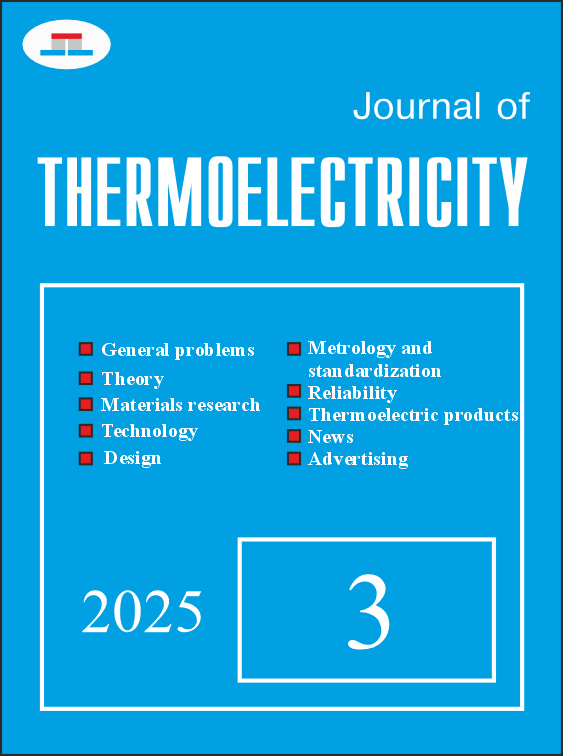Analytical and Numerical Research of Temperature Fields in Cylindrical Thermocouple with Internal Heat Sources
DOI:
https://doi.org/10.63527/1607-8829-2025-3-45-56Keywords:
unsteady heat conductivity, finite integral transformation method, boundary conditions, thermoelectric generator, thermoelectric effects, internal heat sources, temperature field, numerical modelingAbstract
The method of finite integral transformations has been used to analytically solve the problem of unsteady thermal conductivity of a confined cylinder with continuously operating heat sources placed in a medium with a constant temperature. An approach for numerical investigation of thermal fields in cylindrical structures with internal heat sources, taking into account the influence of external conditions, has been proposed. The analytical solution has been numerically implemented, the heat distribution has been numerically simulated, and the thermodynamic behavior of the system has been 3D visualized. The numerical modeling technique has been used to predict the temperature regime in thermoelectric structures with internal heat sources, which is the basis for the engineering design of efficient thermoelectric systems.
References
1. Anatychuk, L., Prybyla, A., Korop, M., Kiziuk, Y., & Konstantynovych, I. (2024). Thermoelectric power sources using low-grade heat: Part 1. Journal of Thermoelectricity, (1-2), 90–96. https://doi.org/10.63527/1607-8829-2024-1-2-90-96
2. Anatychuk, L., Prybyla, A., Korop, M., Kiziuk, Y., & Konstantynovych, I. (2024). Thermoelectric power sources using low-grade heat : Part 2. Journal of Thermoelectricity, (3), 36–43. https://doi.org/10.63527/1607-8829-2024-3-36-43
3. Anatychuk, L., Prybyla, A., Korop, M., Kiziuk, Y., & Konstantynovych, I. (2024). Thermoelectric power sources using low-grade heat: Part 3. Journal of Thermoelectricity, (4), 61–68. https://doi.org/10.63527/1607-8829-2024-4-61-68
4. Cherkez, R., Porubanyi, O., Konstantynovych, I., & Tomko, S. (2025). Computer Study of a Thermocouple with Developed Lateral Heat Transfer. Journal of Thermoelectricity, (1), 37–47. https://doi.org/10.63527/1607-8829-2025-1-37-47
5. Lysko, V., Konstantynovych, I., Havryliuk, M., & Rusnak, O. (2024). Experimental studies on the parameters of thermoelectric generator energy converters with different height of legs. Journal of Thermoelectricity, (4), 50–60. https://doi.org/10.63527/1607-8829-2024-4-50-60
6. Naseem M. B., Lee J., & In S. (2024). Radioisotope thermoelectric generators (RTGs): A review of current challenges and future applications. Chemical Communications. https://doi.org/10.1039/D4CC03980G .
7. Fathy M., Ali M., Abood S. M., Hussein H. A., & Kareem R. A. (2022). A comprehensive review of Radioisotope Thermoelectric Generator. ResearchGate. https://www.researchgate.net/publication/360719626.
8. Karvatskyi A.Ya. (2015). Finite element method in problems of continuum mechanics. Software implementation and visualization of results. Textbook. Kyiv: NTUU “KPI” “Politechnica” Publ.




